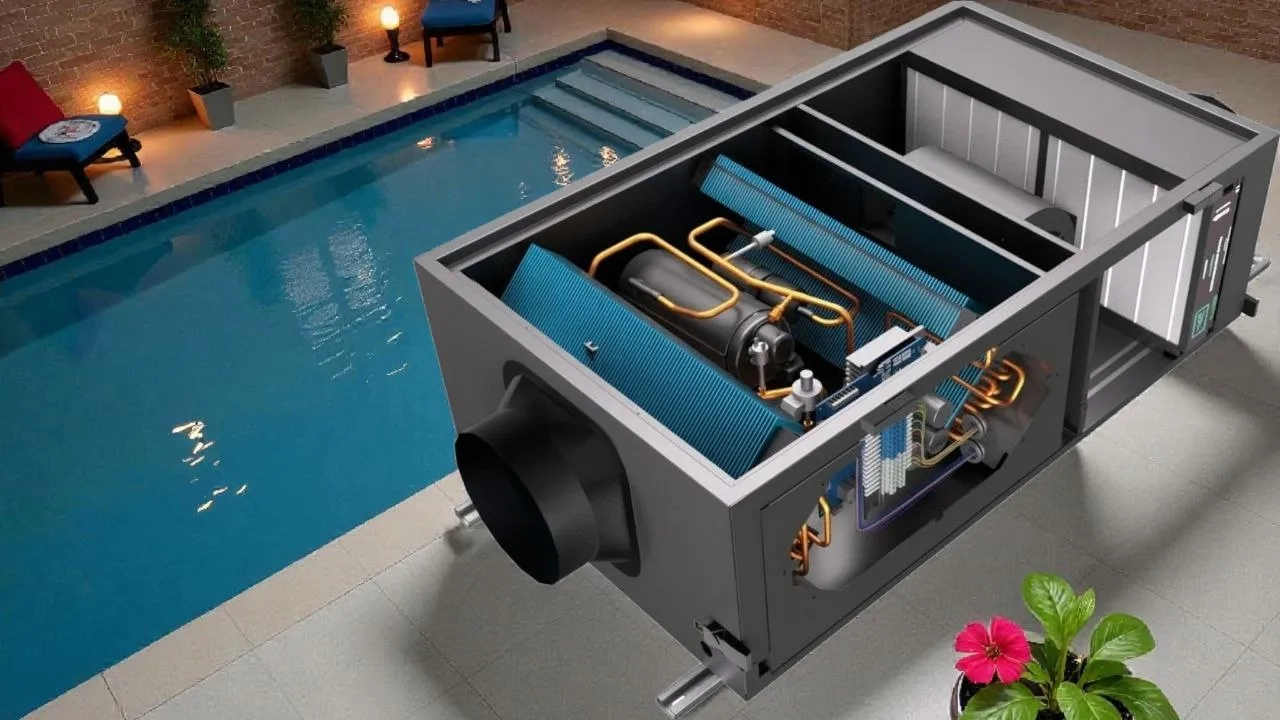
Pool owners often face excessive humidity levels reaching 70–90%. High humidity leads to condensation on walls, windows, and ceilings, mold and mildew growth, accelerated corrosion of metal elements, and overall discomfort for visitors. To maintain a normal humidity level (50–60%), special equipment is required — pool air dehumidifiers.
A properly selected dehumidifier not only maintains a comfortable microclimate but also protects building structures from deterioration, prevents mold growth, and extends the service life of finishing materials. There are three main types of dehumidifiers on the market: wall-mounted, floor-standing, and ducted, each with its own advantages and applications.
In this article, we take a detailed look at the features of each type of dehumidifier, provide a formula for calculating the required capacity, introduce the MBA-G and MSHA(C) model lines from Mycond, and help you choose the optimal solution for your pool.
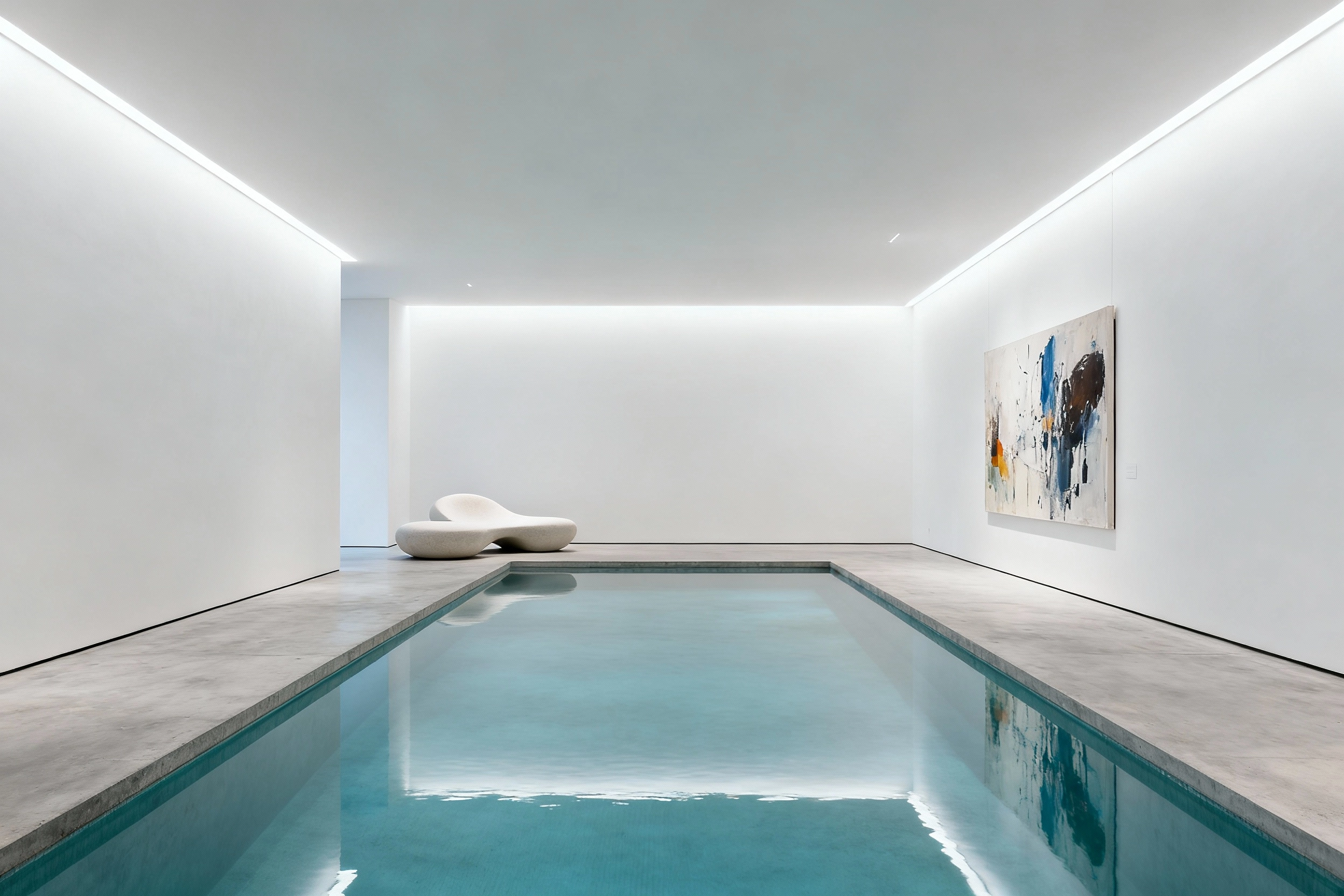
Why Pools Need Dehumidifiers
Sources of Humidity and Evaporation Calculation
The main source of humidity in a pool room is water evaporating from the open surface. The amount of moisture evaporated can be estimated with a simple formula: water surface area (m²) × 0.1 = liters of water per hour. For example, a 5×8 m pool has an area of 40 m², so evaporation will be 40 × 0.1 = 4 L/h, or 96 L/day. This formula is approximate for standard conditions with water temperature 26–28°C and air temperature 28–30°C.
Consequences of High Humidity
High humidity in a pool room leads to a number of serious problems:
- Condensation on windows, walls, and ceiling
- Mold and mildew growth
- Corrosion of metal structures and equipment
- Deterioration of finishing materials
- Discomfort for people, difficulty breathing
- Unpleasant odor
How a Dehumidifier Works
An air dehumidifier works by cooling the air below its dew point. The device draws in moist air and passes it through a cooled heat exchanger, where water vapor condenses. The condensate is collected and drained away, and the dried air is reheated and returned to the room. In this way, the dehumidifier reduces the relative humidity to a comfortable 50–60%.
Three Dehumidifier Types — Overview
Wall-Mounted Dehumidifiers
Wall-mounted dehumidifiers are mounted directly on the wall of the pool room. They are compact, have a modern design, and do not take up usable floor space. The main advantages of wall-mounted dehumidifiers are easy installation, low noise level (44–46 dB), high efficiency, and a direct drain for condensate removal.
The typical capacity range of wall-mounted models is 50–110 L/day, suitable for pools with a surface area of 20–50 m². For example, the Mycond MBA-G series includes three models with capacities from 53 to 108 L/day, allowing you to choose the best option for a specific pool.
Floor-Standing Dehumidifiers
Floor-standing (mobile) dehumidifiers are autonomous wheeled units that can be moved as needed. They are equipped with a water collection tank that needs to be emptied regularly, or they can be connected to a drainage system. Main advantages: no installation required, mobility, relatively low initial cost.
However, floor-standing models have significant drawbacks for pool use: they occupy valuable space, have a high noise level (55–70 dB), insufficient capacity for continuous operation, and often lack special anti-corrosion protection for the aggressive pool environment. Due to these limitations, floor-standing dehumidifiers are not recommended for permanent use in pools and can only be considered a temporary solution.
Ducted Dehumidifiers
Ducted dehumidifiers are installed in a technical/plant room and connected to the pool area via ductwork. This is a professional solution that provides high capacity (from 28 to 1000+ L/day) and is suitable for pools with surface areas from 12 to 417+ m².
Main advantages of ducted dehumidifiers: completely hidden from the pool interior, integration with the ventilation system, high power, and additional options (HEPA filtration, UV lamps, fresh air mixing). The Mycond MSHA(C) series includes 11 models of various capacities, allowing you to select a solution for any facility from large private pools to commercial pools.
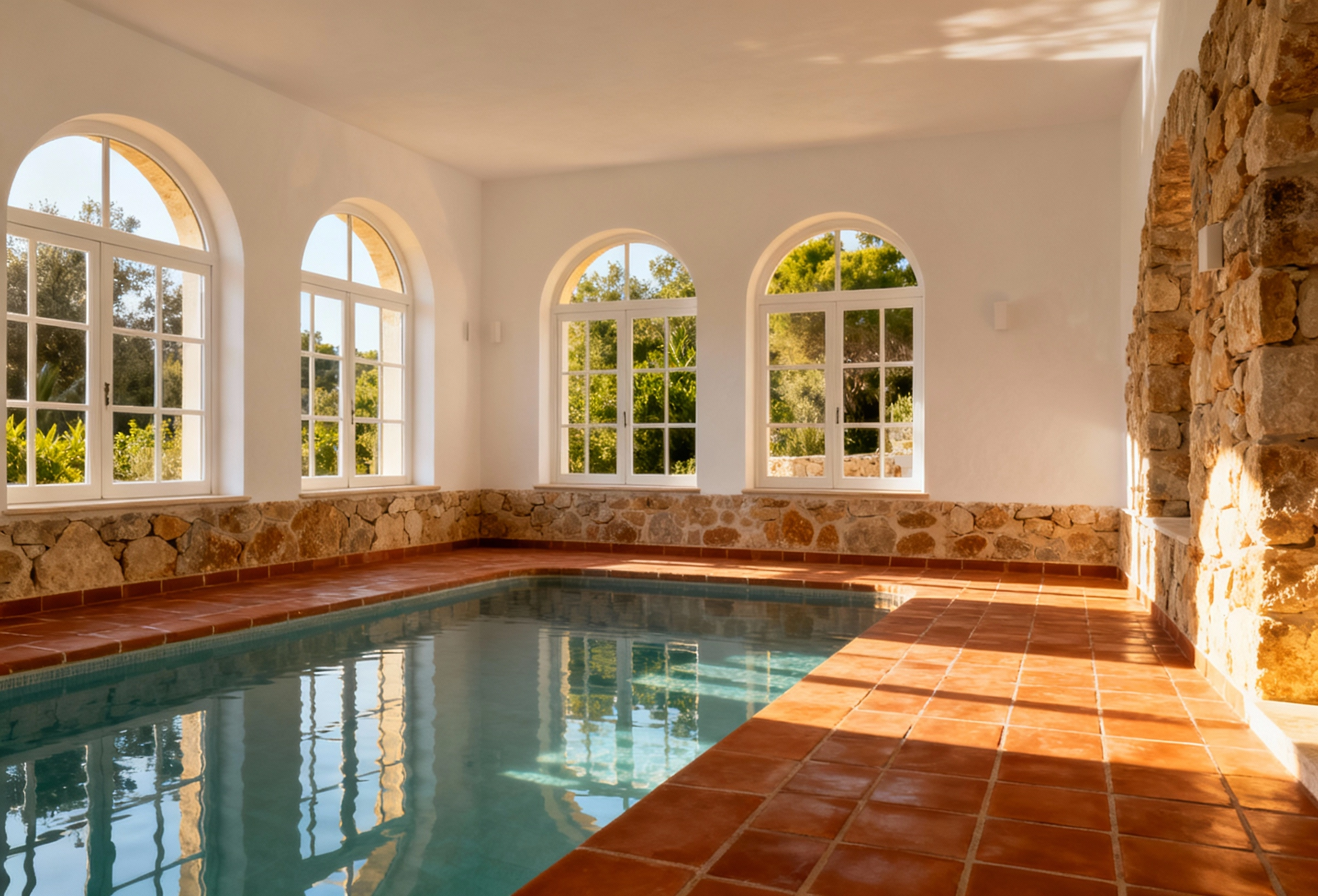
Dehumidifier Selection Algorithm
STEP ONE: Determine the Water Surface Area
The first and most important step is to calculate the water surface area of your pool. Use the formula: length × width = area in m². For example, if your pool measures 4×8 m, the water surface area is 32 m².
STEP TWO: Calculate the Required Dehumidifier Capacity
To calculate how much moisture must be removed, use the formula: water surface area × 0.1 = liters per hour. For daily capacity, multiply the result by 24. For example, for a 40 m² pool: 40 × 0.1 = 4 L/h, or 96 L/day. It is recommended to add a 20% margin to account for additional humidity sources (showers, hot tubs) and peak loads.
STEP THREE: Choose the Dehumidifier Type
Based on the water surface area and the required capacity, you can determine the optimal dehumidifier type:
- Area ≤ 50 m² → WALL-MOUNTED (MBA-G)
- Area 50–100 m² → WALL-MOUNTED high-capacity (MBA10G) OR small DUCTED (MSHA(C) 100–180)
- Area 100–200 m² → DUCTED medium (MSHA(C) 250–380)
- Area > 200 m² → DUCTED large (MSHA(C) 500–1000)
Additional factors when choosing the type of dehumidifier:
When to choose WALL-MOUNTED MBA-G:
- Private pool up to 50 m²
- Pool in a living area where quiet matters (44–46 dB)
- Limited budget
- No technical/plant room
- Need simple installation
- Single-phase 220 V power available
When to choose DUCTED MSHA(C):
- Pool larger than 50 m²
- Availability of a technical/plant room
- Critical aesthetic requirements (equipment must be hidden)
- Readiness for more complex installation with ductwork
- Need to integrate with the ventilation system
- Need for fresh air mixing
- Requirement for maximum filtration (HEPA H13 + UV)
- Commercial facility
- Three-phase 380 V power available for models above 140 L/day
FLOOR-STANDING dehumidifiers are recommended only as a temporary solution.
STEP FOUR: Choose a Specific Model
Wall-Mounted MBA-G:
- Up to 22 m² → MBA05G (53 L/day)
- 22–35 m² → MBA07G (84 L/day)
- 35–50 m² → MBA10G (108 L/day)
Ducted MSHA(C):
- 12–17 m² → MSHA(C) 28
- 17–25 m² → MSHA(C) 60
- 25–42 m² → MSHA(C) 100
- 42–58 m² → MSHA(C) 140
- 58–75 m² → MSHA(C) 180
- 75–104 m² → MSHA(C) 250
- 104–158 m² → MSHA(C) 380
- 158–208 m² → MSHA(C) 500
- 208–312 м² → MSHA(C) 750
- 312–417 м² → MSHA(C) 1000
Important: if the pool area is 50–75 m², the choice between the wall-mounted MBA10G (simple installation) and the ducted MSHA(C) 100–180 (hidden solution) depends on the budget and the availability of a technical/plant room.
STEP FIVE: Check the Specifications
After choosing a model, make sure it meets your requirements by the following parameters:
- Noise level: 44–46 dB for MBA-G or below 55 dB for MSHA(C) in a plant room
- Power supply: 220 V for MBA-G and MSHA(C) up to 140, or 380 V for MSHA(C) 180+
- Dimensions: enough space for installation
- Drainage: ability to connect to a wastewater system
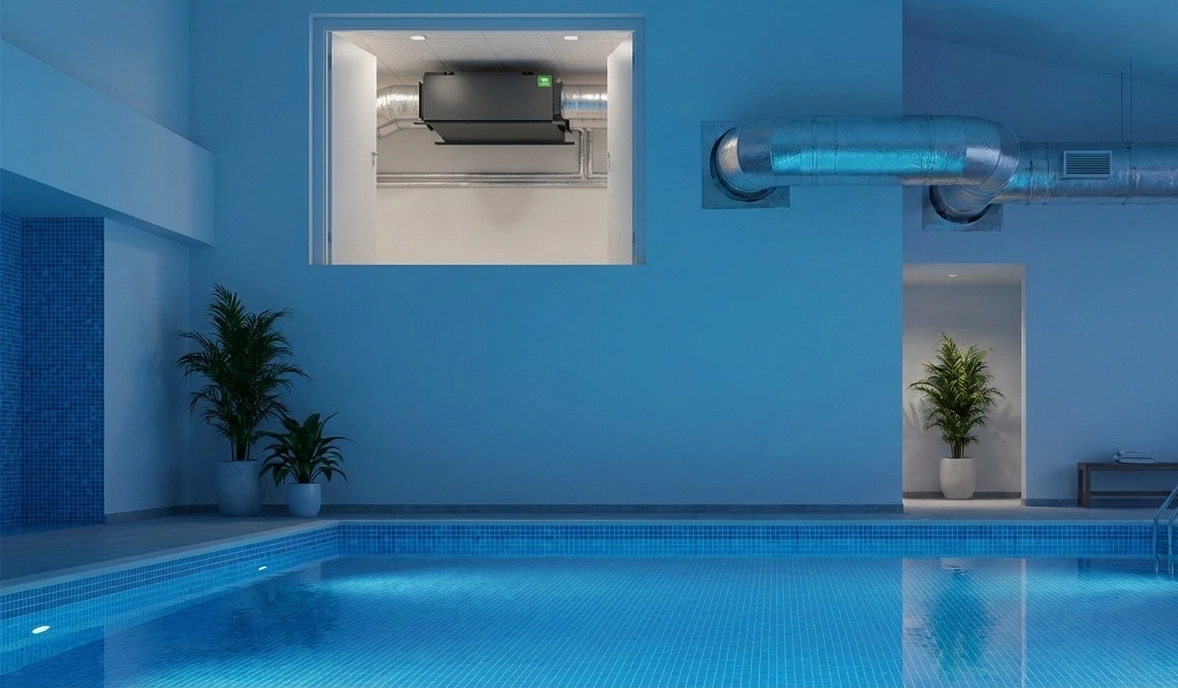
Comparative Table of Dehumidifiers
| Criterion | Wall-Mounted MBA-G | Floor-Standing | Ducted MSHA(C) |
|---|---|---|---|
| Pool area | 20–50 m² | Up to 30 m² (temporary) | 12–417+ m² |
| Capacity | 53–108 L/day | 10–50 L/day | 28–1000 L/day |
| Number of models | 3 | Various | 11 |
| Installation complexity | ★★☆ (Medium) | ★☆☆ (Easy) | ★★★ (High) |
| Equipment cost | ★★☆ (Medium) | ★☆☆ (Low) | ★★★ (High) |
| Installation cost | ★★☆ (Medium) | ★☆☆ (Low/none) | ★★★ (High) |
| Takes floor space | No | Yes | No (in plant room) |
| Noise level | 44–46 dB | 55–70 dB | 35–55 dB (in plant room) |
| Visibility | Visible on wall | Visible on floor | Hidden |
| Corrosion protection | ✓ (gold epoxy) | ✗ | ✓ (hydrophobic coating) |
| Filtration | Basic | Basic | ✓ (up to HEPA H13) |
| Fresh air | ✗ | ✗ | ✓ |
| UV ionizer | ✗ | ✗ | ✓ (option) |
| Power supply | 220 V | 220 V | 220 V / 380 V |
| Mobility | ✗ | ✓ | ✗ |
| Direct drainage | ✓ | ± (not all) | ✓ |
| For private 30 m² | ★★★ (Ideal) | ★☆☆ (Temporary) | ★★☆ (Overkill) |
| For private 80 m² | ★★☆ (Borderline) | ✗ | ★★★ (Ideal) |
| For commercial | ✗ | ✗ | ★★★ (Ideal) |
The choice of dehumidifier type depends on specific conditions and needs. Wall-mounted MBA-G models are optimal for most private pools up to 50 m², where ease of installation and low noise are important. Floor-standing dehumidifiers can be used as a temporary solution but are not suitable for permanent operation in pools. Ducted MSHA(C) dehumidifiers are the best solution for large private and commercial pools, where aesthetics, ventilation integration, and high air quality requirements are important.
Top Five Mistakes When Choosing a Dehumidifier
Mistake 1: Choosing by price rather than pool area
The most common mistake is buying a dehumidifier based only on price without considering the required capacity. An undersized dehumidifier will not cope with the moisture load, resulting in persistently high humidity, condensation, and accelerated deterioration of building structures. The right approach is to first calculate the required capacity using the formula (area × 0.1 × 24 hours) and then select a suitable model.
Mistake 2: Ignoring noise level
Noise level is a critical parameter for pools in residential areas. The difference between 44–46 dB (wall-mounted MBA-G) and 55–70 dB (floor-standing models) is huge: the former allows comfortable conversation and relaxation, while the latter creates constant discomfort and can disrupt sleep if the pool is near bedrooms.
Mistake 3: Using a floor-standing dehumidifier for permanent operation
Using household floor-standing dehumidifiers for pools may seem economical, but it’s a mistake. They are not designed for continuous high loads, lack corrosion protection for the aggressive pool environment, are noisy, take up space, and often have insufficient capacity. In addition, the need to constantly empty the water tank makes them inconvenient for long-term use.
Mistake 4: No direct drainage
Pool dehumidifiers must have the ability to connect directly to the drainage system. Without this feature, you’ll have to regularly empty the condensate tank, which is inconvenient, especially considering that 50 to 100+ liters of water can collect per day. All professional MBA-G and MSHA(C) models have a direct drain (7 mm diameter), ensuring continuous operation without human intervention.
Mistake 5: Choosing without considering corrosion protection
The aggressive pool environment (high humidity, chlorine vapors) quickly disables ordinary equipment without special protection. Professional pool dehumidifiers have special anti-corrosion coatings: gold epoxy in MBA-G and a hydrophobic heat exchanger coating in MSHA(C). This ensures a long service life (10+ years) even under challenging operating conditions.
MyCond Lineup — MBA-G and MSHA(C)
MBA-G: Wall-Mounted Dehumidifiers
The MBA-G wall-mounted dehumidifiers are designed specifically for private pools with a surface area of 20–50 m². This is the optimal solution for 90% of private pools thanks to the ideal balance of price, performance, and quality. Series advantages: simple installation (2–4 hours), quiet operation (44–46 dB, can run overnight), gold epoxy anti-corrosion coating (10+ years of service), compactness (only 248 mm depth).
MBA05G: 2.2 L/h (53 L/day), 450 m³/h, 44 dB, 0.89 kW, dimensions 1343×248×790 mm, refrigerant R32 → pool 20–22 m²
MBA07G: 3.5 L/h (84 L/day), 600 m³/h, 44 dB, 1.09 kW, dimensions 1543×248×790 mm, refrigerant R32 → pool 22–35 m²
MBA10G: 4.3 L/h (108 L/day), 750 m³/h, 46 dB, 1.95 kW, dimensions 1743×248×790 mm, refrigerant R32 → pool 35–50 m²
Unique features of the MBA-G series: gold epoxy anti-corrosion coating, eco-friendly refrigerant R32, compact depth (248 mm), direct drain (7 mm diameter), wide operating temperature range (10–32°C), relative humidity 40–90%.
MSHA(C): Ducted Dehumidifiers
MSHA(C) ducted dehumidifiers are a professional solution for large private (over 50 m²) and commercial pools. They are ideal when interior aesthetics are critical and equipment can be concealed in a technical/plant room.
The lineup includes 11 models with capacities from 28 to 1000 L/day, allowing you to select a solution for pools from 12 to 417+ m². Series features: fresh air mixing to improve ventilation, three-stage filtration (G4 + F7 + HEPA H13), UV lamp and ionizer (option), full integration with the ventilation system.
220 V models:
- MSHA(C) 28: 28 L/day, <35 dB → 12 m²
- MSHA(C) 40: 40 L/day, <45 dB → 17 m²
- MSHA(C) 60: 60 L/day, <45 dB → 25 m²
- MSHA(C) 100: 100 L/day, <45 dB → 42 m²
- MSHA(C) 140: 140 L/day, <45 dB → 58 m²
380 V models:
- MSHA(C) 180: 180 L/day, <55 dB → 75 m²
- MSHA(C) 250: 250 L/day, <55 dB → 104 m²
- MSHA(C) 380: 380 L/day, <55 dB → 158 m²
- MSHA(C) 500: 500 L/day, <55 dB → 208 m²
- MSHA(C) 750: 750 L/day, <55 dB → 312 m²
- MSHA(C) 1000: 1000 L/day, <55 dB → 417 m²
Unique features: HEPA H13 filtration, UV lamp, ionizer, fresh air mixing, hydrophobic heat exchanger coating, integration with ventilation. Models 28–140 L/day run on a single-phase 220 V supply for easy connection. Models 180–1000 L/day require three-phase 380 V power and deliver maximum output for commercial facilities.
Practical Selection Examples
EXAMPLE 1: Private pool 4×8 m (32 m²) in a cottage
Solution: MBA07G (84 L/day)
Why: sufficient capacity, low noise, simple installation, affordable price
EXAMPLE 2: Private pool 6×12 m (72 m²) in a luxury home
Solution: MSHA(C) 180 (180 L/day)
Why: fully hidden from view, sufficient capacity, plant room available
EXAMPLE 3: Hotel pool 10×20 m (200 m²)
Solution: MSHA(C) 500 (500 L/day)
Why: designed for commercial load, integration with general ventilation, HEPA filtration for guest health
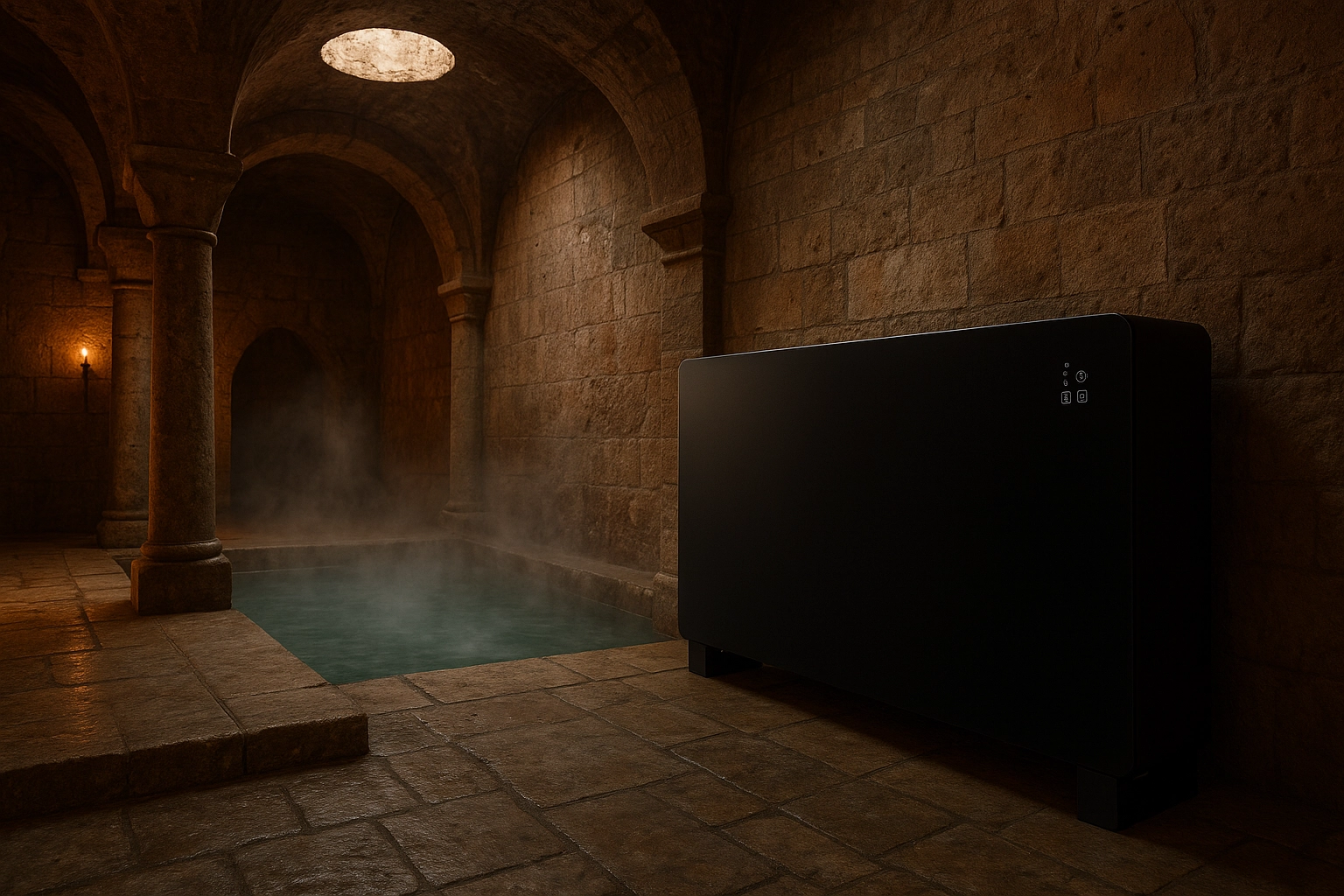
Installation and Operation
Installation of MBA-G wall-mounted units
Installing wall-mounted MBA-G dehumidifiers typically takes 2–4 hours and includes mounting on the wall, connecting the drain and the power supply (220 V). The recommended installation height is 2.5–3 meters above the floor. It is important to ensure free airflow to the unit and properly arrange condensate removal (continuous slope).
Installation of MSHA(C) ducted units
Installing MSHA(C) ducted dehumidifiers is significantly more complex and may take several days. You need a technical/plant room, ductwork design, and electrical connection (220 V for models up to 140 L/day or 380 V for more powerful models). The result is completely invisible equipment, improving the pool room aesthetics.
Operation
MBA-G and MSHA(C) dehumidifiers are designed to operate at temperatures of 10–32°C and relative humidity of 40–90%. They work automatically 24/7, maintaining the set humidity. Built-in controls monitor all parameters, switching the compressor on and off as needed.
Maintenance
Regular maintenance includes: cleaning filters once a month, checking the drainage system every three months, and an annual service inspection by a specialist. Critically important: 70% of dehumidifier problems arise from improper installation, not from equipment quality.
Extended Dehumidifier Sizing Table
| Pool size | Water surface area | Evaporation | Type | Model | Capacity |
|---|---|---|---|---|---|
| WALL-MOUNTED MBA-G | |||||
| Small 3×6 m | 18 m² | 1.8 L/h | Wall-mounted | MBA05G | 53 L/day |
| 4×5 m | 20 m² | 2.0 L/h | Wall-mounted | MBA05G | 53 L/day |
| Medium 4×7 m | 28 m² | 2.8 L/h | Wall-mounted | MBA07G | 84 L/day |
| 5×6 m | 30 m² | 3.0 L/h | Wall-mounted | MBA07G | 84 L/day |
| 4×8 m | 32 m² | 3.2 L/h | Wall-mounted | MBA07G | 84 L/day |
| Larger 5×8 m | 40 m² | 4.0 L/h | Wall-mounted | MBA10G | 108 L/day |
| 5×9 m | 45 m² | 4.5 L/h | Wall-mounted | MBA10G | 108 L/day |
| 5×10 m | 50 m² | 5.0 L/h | Wall-mounted | MBA10G | 108 L/day |
| DUCTED MSHA(C) SMALL (220 V) | |||||
| Large private 6×9 m | 54 m² | 5.4 L/h | Ducted | MSHA(C) 140 | 140 L/day |
| 6×10 m | 60 m² | 6.0 L/h | Ducted | MSHA(C) 140 | 140 L/day |
| DUCTED MSHA(C) MEDIUM/LARGE (380 V) | |||||
| Very large 7×11 m | 77 m² | 7.7 L/h | Ducted | MSHA(C) 180 | 180 L/day |
| 8×10 m | 80 m² | 8.0 L/h | Ducted | MSHA(C) 180 | 180 L/day |
| 8×13 m | 104 m² | 10.4 L/h | Ducted | MSHA(C) 250 | 250 L/day |
| Commercial small 10×13 m | 130 m² | 13 L/h | Ducted | MSHA(C) 380 | 380 L/day |
| 10×16 m | 160 m² | 16 L/h | Ducted | MSHA(C) 380 | 380 L/day |
| Commercial medium 12×17 m | 204 m² | 20.4 L/h | Ducted | MSHA(C) 500 | 500 L/day |
| 15×17 m | 255 m² | 25.5 L/h | Ducted | MSHA(C) 750 | 750 L/day |
| Commercial large 20×17 m | 340 m² | 34 L/h | Ducted | MSHA(C) 1000 | 1000 L/day |
| 20×21 m | 420 m² | 42 L/h | Ducted | MSHA(C) 1000 | 1000 L/day |
Notes:
- Calculation provided for standard conditions: water temperature 26–28°C, air temperature 28–30°C
- For intensive use, presence of hot tubs, showers, it is recommended to choose one model up (+20% capacity)
- MSHA(C) 180 and higher models require three-phase 380 V power
FAQ
How many liters per day should a dehumidifier remove for my pool?
To calculate the required capacity, use the formula: water surface area (m²) × 0.1 = liters per hour. For daily capacity, multiply by 24 hours and add a 20% margin. For example, for a 40 m² pool: 40 × 0.1 = 4 L/h, or 96 L/day. With a margin: 96 + 19.2 = 115.2 L/day. For such a pool, the MBA10G (108 L/day) will suit light use, or the MSHA(C) 140 for intensive use.
Can one dehumidifier run around the clock?
Yes, MBA-G and MSHA(C) dehumidifiers are designed for continuous 24/7 operation. They are equipped with smart controls that monitor humidity levels and switch the compressor on/off as needed. The system automatically maintains the set humidity, operating efficiently and saving electricity.
What is the noise level of MBA-G wall-mounted dehumidifiers?
MBA-G wall-mounted dehumidifiers have an exceptionally low noise level: 44 dB for MBA05G and MBA07G, 46 dB for MBA10G. This allows their use even at night without discomfort. By comparison, floor-standing dehumidifiers operate at 55–70 dB, comparable to a loud conversation or a vacuum cleaner.
Why should a dehumidifier have anti-corrosion coating?
The pool environment is extremely aggressive due to high humidity and chlorine vapors. Ordinary equipment without special protection will fail quickly. MBA-G dehumidifiers have a gold epoxy coating, while MSHA(C) have a hydrophobic heat exchanger coating, ensuring a long service life (10+ years) even under such demanding conditions.
Where does condensate from the dehumidifier go?
All professional pool dehumidifier models have a direct drain (7 mm diameter) for continuous condensate removal. The drain hose connects to the sewer line, ensuring autonomous operation without emptying a tank. It is important to provide a constant slope for gravity drainage.
Can a dehumidifier heat the air?
Yes, dehumidifiers return dried air to the room warmed during operation. In addition, MBA-G models can be connected to a hydronic heater, allowing the dehumidifier to serve as an additional heat source for the pool room.
What is the difference between MBA05G, MBA07G, and MBA10G?
The main differences are capacity and size:
MBA05G: 53 L/day, 1343×248×790 mm, 0.89 kW, for pools 20–22 m²
MBA07G: 84 L/day, 1543×248×790 mm, 1.09 kW, for pools 22–35 m²
MBA10G: 108 L/day, 1743×248×790 mm, 1.95 kW, for pools 35–50 m²
All models offer the same reliability, corrosion protection, and dehumidification technology.
Do I need a dehumidifier if I have ventilation?
Yes. Ventilation only exchanges air; it does not effectively dehumidify it. In the cold season, outdoor ventilation can even increase humidity. A dehumidifier purposefully reduces humidity to 50–60%, which cannot be achieved by ventilation alone. The best solution is a combination of a dehumidifier with controlled ventilation.
When is a ducted MSHA(C) needed instead of a wall-mounted MBA-G?
A ducted MSHA(C) is necessary when: the pool is larger than 50 m², a technical/plant room is available, aesthetics are critical (equipment should be hidden), integration with the ventilation system is required, fresh air mixing is needed, maximum filtration is required (HEPA H13 + UV), the facility is commercial, three-phase 380 V power is available for models above 140 L/day.
What is fresh air mixing in MSHA(C)?
MSHA(C) not only dehumidifies recirculated air but can also mix in fresh outdoor air via a separate duct. This improves air quality, removes CO2 and chlorine vapors without opening windows, which is especially important in cold seasons. This function is not available in wall-mounted models.
Is HEPA filtration necessary in a pool?
For private pools, HEPA filtration is optional but desirable to improve air quality. For commercial facilities (hotels, fitness centers), it is strongly recommended, as it removes 99.5% of fine particles (PM2.5), allergens, and bacteria. HEPA H13 filtration is available in MSHA(C) models as an option.
Which refrigerant is used in MBA-G?
MBA-G dehumidifiers use the modern, eco-friendly R32 refrigerant. It has a low global warming potential, is energy-efficient, and is safe for use in residential spaces.
Conclusion
Choosing the right pool dehumidifier is key to ensuring a comfortable microclimate and long-lasting structures. The sizing formula is simple: water surface area × 0.1 = liters per hour (with +20% margin). Mycond offers 14 dehumidifier models for any pool from 20 to 417+ m².
Wall-mounted MBA-G dehumidifiers are the optimal solution for private pools up to 50 m². They offer an ideal balance of price and quality, simple installation, low noise level (44–46 dB), gold anti-corrosion coating, and the use of eco-friendly R32 refrigerant.
Ducted MSHA(C) dehumidifiers are the professional solution for pools larger than 50 m². They are fully concealed, offer high performance, integration with ventilation, HEPA filtration, UV purification, and fresh air mixing.
Mycond is a segment leader offering comprehensive, modern, and energy-efficient microclimate solutions without overpaying for a global brand. If your pool is up to 50 m² — choose MBA-G; if it is over 50 m² — choose MSHA(C).
Need help selecting a dehumidifier for your pool? Our specialist will help calculate the optimal model considering water surface area, usage intensity, the availability of a technical/plant room, and budget. Call us or fill out the form at the bottom of the page — our engineers have a decade of pool experience and will select the best solution for your facility.